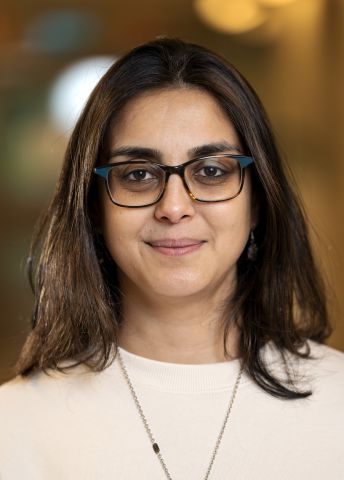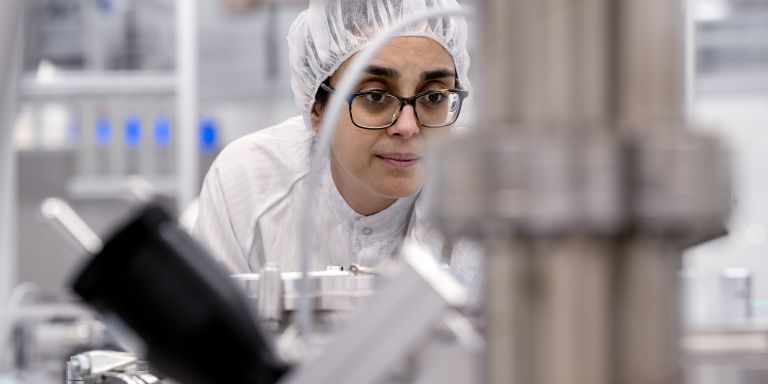
Yasmine Sassa
PhD, Physics
Wallenberg Academy Fellow 2021
Institution:
Chalmers University of Technology
Research field:
Materials physics


Wallenberg Academy Fellow 2021
Institution:
Chalmers University of Technology
Research field:
Materials physics
Information, communication, and technology is part of our everyday life. Our society requires more significant data storage faster data access and transfer, and at the same time, we want to lower energy consumption. A new generation of materials is required to develop smart and energy-efficient devices to sustain the needs of our future society.
“We’re seeing very rapid developments in devices, which are specifically created to carry out artificial intelligence (AI) – so rapid that we need to develop new types of hardware made of materials with magnetic properties that make their responses faster and more efficient than those we have at present,” says Sassa.
Sassa, one of the Wallenberg Academy Fellows, is experimentally fabricating new materials. She focuses on a particular group of oxides called "transition metal oxides." These have properties that render them especially suitable for various electronic applications.
Transition metals are found in the middle of the periodic table of the elements and include many common metals, such as iron, zinc, copper, and gold. Their oxides have variable electrical and magnetic properties; among other things, they can transition from conducting electricity to an insulating state. If multiple metal oxides are combined, they exhibit further properties that may be of use in the electronics of tomorrow.
Sassa is concentrating on the oxides' magnetic properties at interfaces and surfaces. Her research entails building new combinations of materials by placing ultra-thin metal oxide films on top of one another.
"We vary the film substrate and thickness, enabling us to alter the material's magnetic and electronic properties. Using this method, we can tailor the electronic and magnetic properties of the materials so that it has the right properties for a given application," she explains.
The films are just a few atoms thick, which means that quantum effects occur in the interface between them. These phenomena impart magnetic properties to the material that are so unusual they are termed “exotic.” For instance, the oxides may become superconductive, which means they can conduct electric current with zero resistance. Sassa is particularly interested in the magnetic phenomenon known as “magnetic skyrmions.”
Magnetic skyrmions can be described as magnetic nano spin vortices. Due to their nanoscale size and ability to operate with minimal power, skyrmions are anticipated to lead to highly integrated, high-performance devices. One application for these properties could be in new generations of computer memories in the future quantum computers.
Once the thin-film material has been created, Sassa and her team study it carefully to learn more about its properties. For this purpose, Sassa is using a multiple state-of-the-art experimental methodology.
“We also aim to develop theoretical tools based on our experimental results to improve the prospects of creating new and better materials.”
To build the thin films, Sassa has enlisted the help of a network of clean rooms available for nanofabrication run jointly by Chalmers University of Technology, KTH Royal Institute of Technology, Lund University, and Uppsala University.
“One of my goals is to establish my research field on a larger scale than at present. Sweden has an excellent infrastructure to achieve this end. Large-scale research facilities such as MAX IV and the future ESS in Lund offer enormous opportunities.”
She stresses the importance of teamwork to succeed. She hopes that the knowledge she and her team are developing will contribute to a safer society.
“The terrorist attacks of recent years, especially those in my home country, France, have made me worry about the future. As a researcher, I hope my work will ultimately help to create technologies that can improve faster face recognition and make us safer,” Sassa says.
We need new materials to take the next major step after silicon transistors – quantum mechanisms in the materials will be key to our success.
Sassa came to Sweden in 2015 after her Ph.D. and a postdoctoral fellowship from the Paul Scherrer Institute and ETH Zurich in Switzerland. Already, as a Master's student, she has been fascinated by the scientific possibilities large-scale infrastructures offer. Those facilities enable her to create an in-depth understanding. She elaborates:
"For me, a key driver has always been to understand the properties of new materials before we reach an application. We must do our homework so we avoid unpleasant surprises later on."
Her thirst for knowledge began in France when she was a young girl. She often visited local science museums with her brother. But sometimes, her boundless curiosity also caused the family problems:
"My mother has told me how I dismantled both our TV and our radio so I could see how they worked. Unfortunately, no one managed to put them back together again, and my parents were pretty mad," Sassa says.
Text Magnus Trogen Pahlén
Translation Maxwell Arding
Photo Johan Wingborg